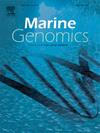Genomic analysis of Marinimicrobium sp. C6131 reveals its genetic potential involved in chitin metabolism
Abstract
Marinimicrobium sp. C6131, which had the ability to degrade chitin, was isolated from deep-sea sediment of the southwest Indian Ocean. Here, the genome of strain C6131 was sequenced and the chitin metabolic pathways were constructed. The genome contained a circular chromosome of 4,207,651 bp with a G + C content of 58.50%. A total of 3471 protein-coding sequences were predicted. Gene annotation and metabolic pathway reconstruction showed that strain C6131 possessed genes and two metabolic pathways involved in chitin catabolism: the hydrolytic chitin utilization pathway initiated by chitinases and the oxidative chitin utilization pathway initiated by lytic polysaccharide monooxygenases. Chitin is the most abundant polysaccharide in the ocean. Degradation and recycling of chitin driven by marine bacteria are crucial for biogeochemical cycles of carbon and nitrogen in the ocean. The genomic information of strain C6131 revealed its genetic potential involved in chitin metabolism. The strain C6131 could grow with colloidal chitin as the sole carbon source, indicating that these genes would have functions in chitin degradation and utilization. The genomic sequence of Marinimicrobium sp. C6131 could provide fundamental information for future studies on chitin degradation, and help to improve our understanding of the chitin degradation process in deep-sea environments.

 求助内容:
求助内容: 应助结果提醒方式:
应助结果提醒方式:


